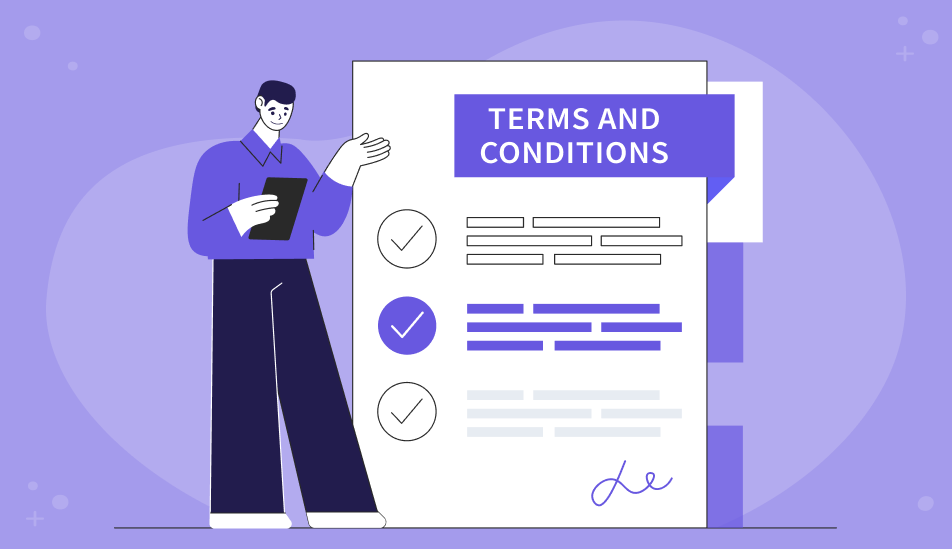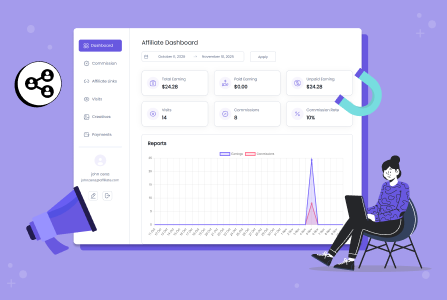How to Set Up Affiliate Terms and Conditions (The Right Way)

- The Framework: How to think about your affiliate terms & conditions
- 1. Protect the business
- 2. Set fair expectations for affiliates
- 3. Make it easy to understand
- Enrollment / application process and eligibility requirements
- How to describe your enrollment / application process
- Eligibility requirements
- Approval and rejection of affiliate applications
- Affiliate obligations, merchant obligations & relationship status
- Affiliate Obligations
- Merchant / Company Obligations
- Promo rules: How affiliates are allowed to promote you
- Affiliate links and tracking
- Conclusions on Setting Up Affiliate Terms and Conditions
When you’re launching your own affiliate program (even a small one like for a handmade crafts store), your Terms & Conditions are not just ‘nice to have’ or ‘must-have’ fluff.
You need to set up your affiliate terms and conditions to avoid drama like “But you never said I can’t bid on your brand name in Google Ads!”. Yes you did. In your T&Cs.
Think about your prospective partners, your terms are a rulebook, the safety net, and the expectations document for both sides – you and them.
In this blog, we want to explain how to present affiliate terms and conditions to them clearly on your website, especially if you’re a WordPress + WooCommerce site owner running a self-registered or manually approved affiliate program.
The Framework: How to think about your affiliate terms & conditions

Start with your “priority plan” – what matters most in your terms and conditions? When creating your affiliate T&Cs, think in this order:
1. Protect the business
- Prevent fraud and abuse.
- Make it clear when you can reject or remove an affiliate.
- Protect your brand, your money, and your customers.
2. Set fair expectations for affiliates
- What they can expect to earn (affiliate commission types, payment schedule).
- What they’re allowed/not allowed to do.
3. Make it easy to understand
- Simple language.
- Clear headings, bullet points, and examples.
- No hidden traps.
Furthermore, we recommend that you think of your Terms & Conditions page as:
- Contract (it can be legally binding).
- A handbook (how to behave in your program).
- A filter (who is allowed to get in).
Don’t copy-paste from a random big brand and hope it’s what you need and saves you time! Their risk level, audience, and legal environment might be totally different. Try your best to adapt it to your realities:
1. Start from your real business reality (small shop? solo founder? handmade goods?).
2. Use examples that match how people actually promote you (blogs, Instagram, YouTube).
3. Get at least a light review from a legal professional (we know it’s a commitment but it’s super cool to get one).
Enrollment / application process and eligibility requirements

This is the first thing a potential affiliate will check. They want to know: “Can I join? What do I need?”
How to describe your enrollment / application process
Explain step-by-step how someone becomes an affiliate with your affiliate program. For example (adapt this to your WordPress/WooCommerce site):
- Fill out the application form on our website.
- Tell us how you plan to promote our products (website, social media, email list, etc.).
- We’ll review your application within X days.
- If approved, you’ll receive your login details and unique affiliate link by email.
Here, many major things need to be clarified:
- Whether you accept self-registration (anyone can apply) or only manually curated partners.
- How long approval usually takes.
- Whether you contact people if they’re rejected, or only if approved.
- If they can re-apply later if rejected.
Eligibility requirements
This is where you decide who is actually a good fit for your affiliate program. Common criteria you might include:
- Type of content (blog, social media, etc.). Content must be related to your niche (e.g., crafts, DIY, handmade, home decor, gifts).
- Quality standards – no hate speech, violence, adult content, or anything illegal.
- Location / age (e.g, at least 18 years old and must be legally able to enter into a contract in their country).
- Ethical and legal compliance.
We think it makes sense to make it clear that meeting eligibility requirements does not guarantee approval. Your right to say no is iron.
Approval and rejection of affiliate applications

Look for partners who have already made an effort to promote you. But if not… You need to do it nicely to protect your sanity. You need to describe the freedom to reject applications that don’t fit and not argue about it:
“We reserve the right to approve or reject any application at our sole discretion, with or without giving a reason”.
What can you reject? Depends on your product and goals, for example:
1. Website or social content is not relevant to your products.
2. Absence of a site or previous mentions of your products.
3. low-quality content (placeholder sites, copied content, etc.). False or discrimination-based content is also a good reason to say no.
As for re-application, decide if they can improve their website and apply again or whether there is a minimum waiting period before re-applying.
Affiliate obligations, merchant obligations & relationship status

Once they’re in, what do you both owe each other?
Affiliate Obligations
So, in this section, you should state what they must do and must not do. A few examples of how to write your Affiliate Terms and Conditions in this case:
- Use their own unique link (no sharing someone else’s link).
- Promote honestly (don’t use false claims about your products or advertise misleading offers).
- Follow your promo rules.
- Respect your brand guidelines, trademarks, and coupon rules.
- Comply with spam laws.
- Keep account info up to date (payment details, name, email).
Merchant / Company Obligations
What do your affiliate partners expect from you?
- Working tracking links and a way to see clicks/sales (through your plugin or affiliate dashboard panel).
- Pay commissions on time according to the payment terms (state your payment methods).
- Provide accurate information about products and pricing.
- Give support and communication channels.
Moreover, a relationship status is very important, and normally, to protect you from labor problems, it’s an ‘independent contractor’. You must clarify that affiliates are not your employees. State things like:
“Affiliates are independent contractors, not employees, partners, or agents. They are responsible for their own taxes and legal obligations”.
Promo rules: How affiliates are allowed to promote you

Now let’s briefly go through the main “how you can promote us” rules. In this part, explain approved marketing tactics in the way you feel relevant to your business.
Tell affiliates where to get banners, logos, and creatives, and what they can or can’t change. Provide your logo files, banners, and product photos. With affiliate marketing plugins like AffiliatePress, you can upload creative assets to allow affiliates to choose what to use.
Explicitly state more rules, e.g. that editing a logo is forbidden, or if they create their own designs, they must still follow your brand guidelines.
As for logos, trademarks, and trade names:
- Affiliates can use your logo solely to promote your products.
- They can’t change the logo colors or shape.
- They can’t use your logo as their profile picture or company logo.
- They can’t register trademarks or domains that are confusingly similar to yours.
- Affiliates must clearly be third parties, not pretending to be you.
If paid search / PPC / Google Ads is relevant, explain:
- Whether they can bid on your brand name keywords (e.g., “YourBrand”, “YourBrand Coupon”).
- Whether they can use your brand in ad copy.
- Whether they must send traffic to their own landing page first (no direct linking to your site via ads).
If you don’t want any PPC at all, say so clearly:
“Affiliates are not allowed to run paid search ads that lead directly or indirectly to our website.”
If you allow coupon sites, explain if your partners can promote exclusive coupons or only public ones. Whether you’ll pay commission if the customer originally came from another affiliate and then just searched for a coupon.
Affiliate links and tracking

Surely, you need to explain how links and tracking work for affiliates. Your partners are expecting something like (make sure to adjust to your rules) –
- You get a unique link that tracks visitors you send.
- When someone clicks your link and buys, you earn a commission (if it’s a valid sale).
Tracking methods (cookies, tracking IDs):
- We mostly use cookies and tracking IDs to remember that a customer came from you.
- If they switch devices or clear cookies, tracking may not always work.
Cookie duration / cookie lifetime:
- We’ll state how long we keep tracking after a click (e.g., 30 days).
- If the customer buys within that window, you get the commission.
Last-click / first-click attribution rules:
- Last-click, the most recent affiliate link before purchase gets the commission (very common).
- First-click, the first affiliate who sent the visitor gets it (less common).
Make clear which model you use.
Commission structure:
- Explain if it’s a flat rate per sale (e.g., $5 per order) or a percentage (e.g., 10% of order value). AffiliatePress gives you multiple options, even when you need to optimize them to specific products on your WooCommerce-based or any other store.
- You can offer different rates for different product categories.
Commission rates and tiers:
- Basic rate for new affiliates, higher rate if they hit certain sales milestones.
Qualified sales:
- Only real, paid orders (no test orders, no free products).
- No self-purchases (if you want to forbid that).
- No orders that are refunded, cancelled, or flagged as fraud.
Validation period:
- A period (e.g., 30-60 days) after the sale where you wait to see if the order gets cancelled or refunded.
- Commissions for that order are only confirmed after the lock period.
Payment terms and threshold:
- When you pay (e.g., once a month, bi-weekly).
- Threshold (the minimum amount before you send a payment, e.g., $50).
- Payment methods and fees (PayPal, bank transfer, store credit).
- Country limitations.
Conclusions on Setting Up Affiliate Terms and Conditions
Why give your affiliate terms and conditions so much attention?
With these guidelines, you avoid losing money, e.g. without clear rules on fraud, refunds, and invalid sales, you may end up paying commission on fake or refunded orders.
One more important thing – you take care of your brand image for the long run. Affiliates can damage your reputation with spammy tactics if you don’t restrict them. And finally, you surely want to cater to serious affiliates who prefer clear, well-written terms to feel they are working with professionals. Prepared to get your T&Cs draft ready?
Related articles:




